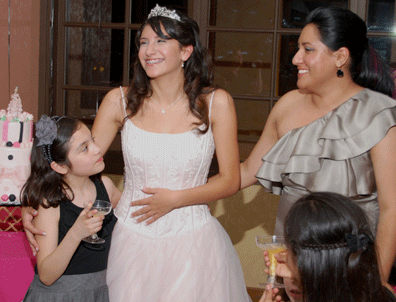
One of the most important and enduring celebrations in Mexican culture is the tradition of the quinceañera. Much more than just a girl’s fifteenth birthday party, it’s a family milestone that marks a girl’s symbolic passage to womanhood and presents her to the community. The quinceañera celebration has its origins from the Aztecs and has evolved into a grand family celebration on the scale of a wedding. The quinceañeras wear dresses that can be just as expensive as a wedding gown and families often spend a lot of money for the event regardless of how well they can afford the expense.
Planning begins up to a year in advance, and requires the resources of several members of the family and friends. “In these times with tight budgets, I have seen parties where they have almost a hundred padrinos”, said Silvia Castellanos of Fotografia Medina in San Leandro.
Before the tradition was that the quinceañera will wear a pink dress but now, “the girls want to wear extravagant outfits”, said Castellanos. “The colors for the dresses are purple, green, fuchsia, orange, turquoise, and obviously all strapless”.
Generations ago, the wealthy used to provide a trip to Europe for their young lady, frequently to Paris. Today, presents range from cash to clothing. The party is a big affair, traditionally lasting for at least six hours. The parents, godparents, and often other families go all-out to make the party an absolutely over-the-top experience. A central component is the cake, which often reflects the girl’s quinceañera gown in its marvelous decoration.
Frank Hernandez at Raja Restaurant in Hayward has seen a lot of interesting things at the many quinceñera parties they host each year, some with as many as five hundred people in the restaurant and outside terrace. “Families request everything from the traditional to the extravagant,” says Hernandez. Horse and carriage that delivers the quinceañera to the party, mariachi bands, stretched limousines, and banda music bands from Mexico are among the features he has seen.
Being a party, there is always dancing and often a live band performing contemporary dance music or cumbia, banda, salsa, and traditional Mexican songs. The festejada traditionally opens the party officially by dancing a waltz with her father or primary escort. A formal dinner is featured at the party as well. There is also a brindis or toast, in which people remark on the celebrant with pride and fond memories of her youth. This is also the occasion when the parents impart special messages, transferring wisdom and life-experience to their daughter.
The importance of the quinceañera for a family cannot be underestimated. “Every family I speak to says it’s a very important thing in a young woman’s life coming to womanhood,” says Hernandez.
Surprising is the fact that while the quinceañera celebration is a Mexican tradition, places like Raja have hosted many quinceñera celebrations for people with family roots in Central and South America. “We’ve had families from almost every Central and South American country - El Salvador, Guatemala, Peru, and others,” says Hernandez.
Some families take the opportunity of the quinceañera to add non-traditional aspects, such as Indian food, which Raja specializes in along with Mexican food. “In addition to the food of their own culture, families will sometimes request a couple of Indian dishes such as chicken or lamb curry,” he adds.
Latino families are mindful of their rich inheritance and the quinceañera celebration is among the most meaningful and beautiful occasions.

